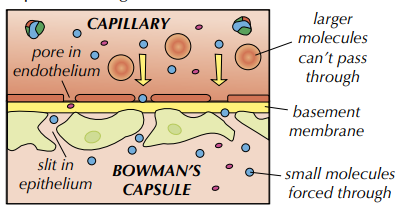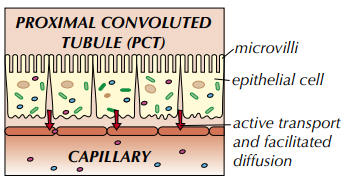Homeostasis
The maintenance of a constant internal environment. Things like our temperature, blood pH and blood glucose concentration needs to stay relatively stable in order to keep our cells functioning effectively.
What happens when conditions fluctuate
Enzymes will become denatured.
Fluctuations in temperature result in hydrogen bonds breaking within the enzyme’s structure
Changes in pH cause hydrogen and ionic bonds to break.
The enzyme loses the shape of its active site and can no longer catalyse important biological reactions,
Negative feedback
Mechanisms which act to reverse a change in the body - i.e. if temperature increases, a negative feedback mechanism ensures that changes to our body occurs in order to reduce our body temperature.
How does negative feedback occur

The change in our body is detected by receptors (e.g. thermoreceptors which detect temperature or chemoreceptors which detect pH) and the reversal of the change is brought about by effectors (such as sweat glands which can modify the amount of sweat produced in order to change our body temperature)
Positive feedback

Mechanisms which amplify a detected change, moving conditions away from the normal level. They are used to accelerate a biological pathway, for example, the formation of a blood clot after an injury.
What organ controls blood glucose concentration
Pancreas
What hormones control blood glucose concentration
Insulin- reduces blood glucose levels, produced in Beta cells
Glucagon- increases blood glucose levels, produced in alpha cells
Describe what happens when blood glucose concentration is high
Cells in the pancreas detect high blood glucose and stimulate beta cells in the islets of Langerhans to secrete insulin.
Insulin travels in the bloodstream to liver and muscle cells, where it binds to insulin receptors on their cell surface membrane.
Insulin increases the permeability of the membrane to glucose, so more glucose is moved from the bloodstream into cells. When insulin binds to its receptor, vesicles containing the GLUT4 glucose transporter move and fuse with the plasma membrane.
It also stimulates the conversion of glucose into glycogen (glycogenesis) and an increase in the rate of respiration, which helps to lower blood glucose.
Describe what happens when blood glucose concentration is low
Cells in the pancreas detect low blood glucose and stimulate alpha cells in the islets of Langerhans to secrete glucagon.
Glucagon travels in the bloodstream to liver cells, where it binds to glucagon receptors on their cell surface membrane.
Glucagon stimulates the breakdown of glycogen into glucose (glycogenolysis) and a decrease in the rate of respiration, which helps to increase blood glucose.
It also triggers the production of glucose from non-carbohydrates, such as lipids and amino acids, in a process called gluconeogenesis.
Describe the function of adrenaline in controlling blood glucose concentration
Adrenaline is secreted by adrenal glands when glucose concentration is low, when stressed or when exercising
It binds to receptors in cell membrane of liver cells
It activates glycogenolysis (the breakdown of glycogen to glucose)
It inhibits glycogenesis (the synthesis of glycogen from glucose)
It also activates glucagon secretion and inhibits insulin secretion, which increases glucose concentration
Adrenaline gets the body ready for action by making more glucose available for muscles to respire.
secondary messengers
hormones such as adrenaline, glucagon and insulin can’t get inside target cells to exert their effects directly, they have to use second messengers to activate reactions inside cells
Describe the function of secondary messengers in adrenaline
Adrenaline binds to its receptor on the cell surface membrane of liver cells.
This activates the enzyme adenylate cyclase, which converts ATP into a second messenger called cyclic AMP (cAMP).
cAMP activates an enzyme called protein kinase A, which activates a cascade which eventually leads to the breakdown of glycogen (glycogenolysis).
Glucose processes to remember
Describe Type 1 diabetes
The immune system destroys the beta cells of the islets of Langerhans so that they can no longer produce insulin.
Results in sustained hyperglycaemia (high blood glucose) after a meal. Some glucose is excreted in the urine as the kidneys cannot reabsorb all of the glucose.
Treated with insulin injections or an insulin pump. The amount of injected insulin has to be carefully controlled to prevent glucose from dropping too low.
Patients also have to follow a carefully controlled diet.
Describe Type 2 diabetes
Body cells stop responding properly to insulin because their insulin receptors stop working and their cells stop absorbing glucose, leading to elevated blood glucose levels.
Treated with a managed diet and regular exercise. In more severe cases, glucose-lowering drugs or insulin injections may be used.
Type 2 diabetes is becoming more common due to increasing availability of processed foods and low levels of physical exercise.
Describe Ultrafiltration
A process in the kidneys where blood is filtered under pressure in the glomerulus, allowing water, ions, and small molecules to pass into the Bowman's capsule while retaining larger molecules like proteins and blood cells.
Name the arteriole that takes blood into the glomerulus
Afferent arteriole
Name the arteriole that takes blood away from the glomerulus
Efferent arteriole
Describe the difference between the arteriole that enters the glomerulus and leaves the glomerulus and explain how this aids ultrafiltration.
The efferent arteriole is smaller in diameter than the afferent arteriole, so the blood in the glomerulus is under high pressure. The high pressure forces liquid and small molecules in the blood out of the capillary and into the Bowman’s capsule.
Name the three layers molecules pass through to get into Bowman’s capsule
the capillary endothelium
the basement membrane
the podocytes (epithelium of Bowman’s capsule)

Describe selective reabsorption
The process by which the kidneys reabsorb essential substances from the filtrate back into the blood, such as glucose, amino acids, and certain ions, while allowing waste products to remain in the urine.
What parts of the urinary system are involved in selective absorption
The proximal convoluted tubule (PCT)
loop of Henle
Distal convoluted tubule (DCT)
Describe the function of the DCT in selective reabsorption
Glucose is reabsorbed in the PCT by active transport and facilitated diffusion. The PCT epithelium has microvilli to provide a large surface area for reabsorption.

How is water absorbed in selective reabsorption
Water is reabsorbed in the loop of Henle, DCT and collecting duct by osmosis.
Describe osmoregulation
The process by which the kidneys regulate the water potential of the blood (and urine), so the body has just the right amount of water
Describe what happens when you are dehydrated
water potential of the blood is too low
more water is reabsorbed by osmosis into the blood from the tubules of the nephrons
means the urine is more concentrated, so less water is lost during excretion
Describe what happens when you are too hydrated
water potential of the blood is too high
less reabsorption of water from the nephron tubules.
results in more diluted urine, as excess water is excreted.
The loop of Henle and controlling blood water potential diagram
Describe how the Loop of Henle is involved in water absorption
The ascending limb is permeable to ions but impermeable to water. Sodium ions are actively pumped into the medulla which lowers the water potential of the medulla
This causes water to move out of the descending limb (which is permeable to water but not ions).
As water moves out of the descending limb, the filtrate becomes more concentrated.
This causes sodium ions to move out of the nephron at the start of the ascending limb, down their concentration gradient by facilitated diffusion.
This lowers the water potential of the medulla even further, causing water to move out of the DCT and collecting duct by osmosis.
Water that has moved into the medulla moves into the capillary.
How is water potential monitored?
The water potential of the blood is monitored by cells called osmoreceptors the hypothalamus
What gland is involved in controlling water potential
The posterior pituitary gland
What hormone does the posterior pituitary gland release?
Antidiuretic hormone (ADH)
How does ADH increase water absorption
ADH molecules bind to receptors on the plasma membranes of cells in the DCT and the collecting duct.
protein channels called aquaporins are inserted into the plasma membrane which allow water to pass through via osmosis
makes the walls of the DCT and collecting duct more permeable to water
more water is reabsorbed from these tubules into the medulla and into the blood by osmosis.
Describe how the hypothalamus responds to dehydration
The water content of the blood drops, so its water potential drops.
This is detected by osmoreceptors in the hypothalamus.
The posterior pituitary gland is stimulated to release more ADH into the blood.
More ADH means that the DCT and collecting duct are more permeable, so more water is reabsorbed into the blood by osmosis.
Describe how the hypothalamus responds to hydration
The water content of the blood rises, so its water potential rises.
This is detected by the osmoreceptors in the hypothalamus.
The posterior pituitary gland releases less ADH into the blood.
Less ADH means that the DCT and collecting duct are less permeable, so less water is reabsorbed into the blood by osmosis.
A large amount of dilute urine is produced and more water is lost.